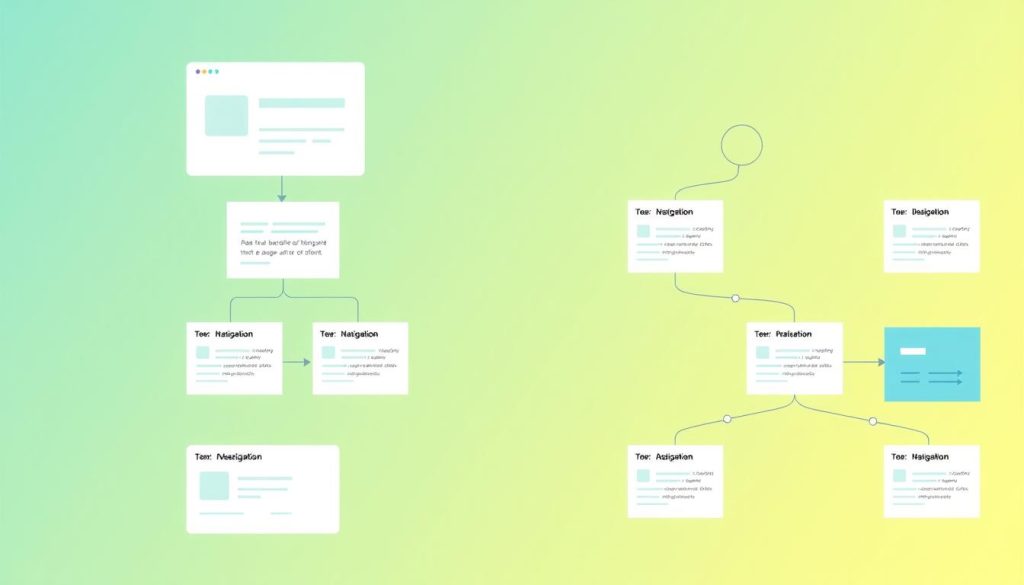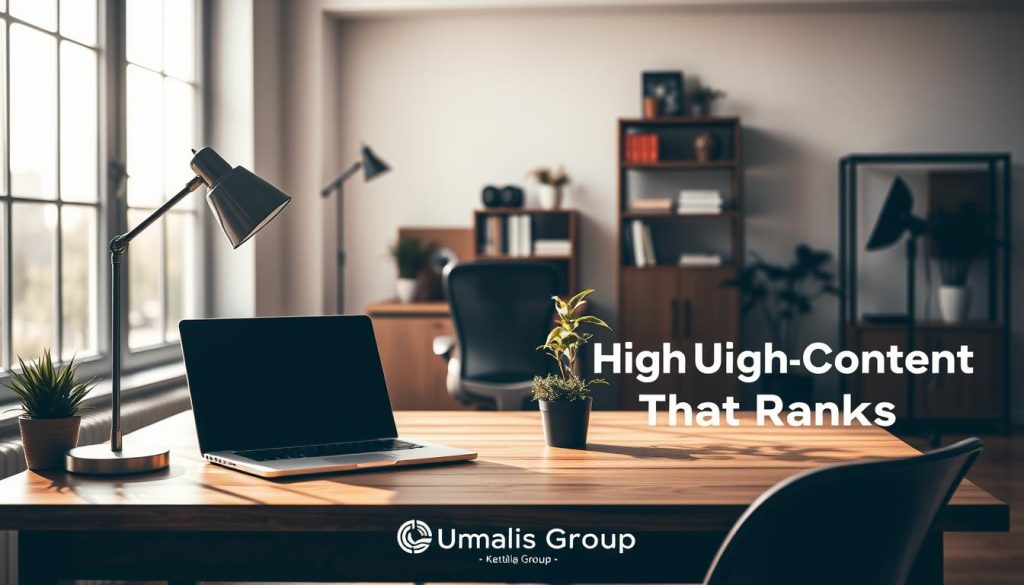In today’s competitive digital landscape, achieving a strong online presence is crucial for professional visibility and business success. With over 68% of online activities starting with a search engine query, it’s essential to ensure your website is optimized for search engines.
Understanding how search engines evaluate and rank content is vital to improving your website’s visibility. By implementing effective strategies, you can boost your position in search engine results pages (SERPs) and drive more traffic to your site. For professionals looking to enhance their online presence, hiring an SEO specialist can be a game-changer.
Our comprehensive guide will walk you through proven techniques to optimize your website, covering everything from technical elements to content creation best practices that search engines reward with higher rankings.
Table of Contents
Key Takeaways
- Understand how search engines evaluate and rank content
- Learn effective strategies to boost your website’s visibility
- Discover the importance of technical SEO elements
- Improve your content creation skills for better rankings
- Enhance your online presence with expert tips
Understanding How Search Engines Work
The way search engines work is fundamental to developing an effective SEO plan. To improve your website’s visibility, you need to understand the complex processes behind search engine functionality.
Search engines operate through sophisticated algorithms that determine which web pages appear in response to specific search queries. The foundation of search engine functionality begins with crawling, where specialized bots systematically discover and navigate through web content.
The Crawling and Indexing Process
Google’s crawlers continuously explore the internet, following links from page to page and building an index of content they encounter. During the indexing process, search engines catalog and organize discovered content, making it available to appear in search results when relevant.
| Process | Description |
|---|---|
| Crawling | Specialized bots discover and navigate through web content. |
| Indexing | Search engines catalog and organize discovered content. |
| Retrieval | Content is retrieved from the index to appear in search results. |
How Google Evaluates and Ranks Content
Understanding how search engines evaluate content quality is crucial—they assess factors like relevance, authority, user experience, and technical performance. Google uses hundreds of ranking signals to determine which content deserves to appear at the top of search results for specific queries.
The E-E-A-T principle (Experience, Expertise, Authoritativeness, and Trustworthiness) has become increasingly important in how Google evaluates content quality. By focusing on these aspects, you can significantly improve your website’s ranking.
By recognizing how search engines process and evaluate your content, you can implement effective SEO strategies that improve rankings. This understanding is the first step toward maximizing your online visibility.
Optimizing Your Site Structure for Better SEO Ranking
A well-organized site structure is the backbone of effective SEO, enhancing both user experience and search engine crawling. Your site’s structure plays a pivotal role in how search engines understand and rank your content. By optimizing your site structure, you can significantly improve your SEO ranking.

Creating Descriptive and SEO-Friendly URLs
Creating descriptive, keyword-rich URLs is crucial for helping search engines understand your page content. This not only improves user experience but also enhances your site’s visibility in search results. Descriptive URLs can appear as breadcrumbs in search results, providing users with contextual information about your site’s organization.
Organizing Content with Logical Directory Structures
Implementing a logical directory structure groups related content together, making it easier for search engines to crawl and index your site. For sites with numerous URLs, organizing content into thematic categories and subcategories creates a hierarchy that search engines can follow to understand content relationships. You can read more about how search engines work and the importance of site structure in our detailed guide on Google algorithms and search rankings.
Reducing Duplicate Content Issues
Duplicate content can dilute your SEO efforts by forcing search engines to choose which version to rank. Implementing canonical tags helps search engines identify your preferred version of content when multiple similar pages exist. Regular content audits can also identify structural issues like orphaned pages or excessive redirects that may be hampering your SEO performance.
By focusing on these aspects of site structure optimization, you can create a solid foundation for your SEO strategy, improving both user experience and search engine rankings.
Creating High-Quality Content That Ranks

In the world of SEO, high-quality content is not just a nicety, but a necessity for ranking success. Creating content that people find compelling and useful will likely influence your website’s presence in search results more than any other factor.
Writing for Users First, Search Engines Second
When creating content, it’s essential to write for users first and search engines second. This means focusing on clarity, relevance, and usefulness rather than keyword density or other outdated optimization techniques. By doing so, you’ll not only improve the user experience but also increase your chances of ranking higher in search results.
- Prioritize clarity and concision in your writing.
- Use headings and subheadings to structure your content.
- Incorporate relevant multimedia elements to enhance user engagement.
Optimizing Content Readability and Organization
To optimize content readability and organization, break up long blocks of text into paragraphs and sections, and provide headings to help users navigate your pages. This not only improves the user experience but also helps search engines understand your content‘s information hierarchy and main points.
Keeping Content Fresh and Updated
Regularly auditing and refreshing existing content can revitalize declining traffic and improve rankings as search engines favor up-to-date information. Check in on previously published content and update it as needed, or even delete it if it’s no longer relevant. For more expert tips on boosting your search engine ranking, explore our comprehensive guide.
By following these guidelines and creating high-quality content, you’ll be well on your way to improving your website’s visibility and ranking in search results.
Keyword Strategy for Maximum Visibility

Effective keyword research involves identifying relevant terms and phrases that your target audience uses when searching online. This process is crucial for developing a comprehensive keyword strategy that aligns with your content and enhances your online visibility.
Conducting Effective Keyword Research
To conduct effective keyword research, you need to identify terms your target audience uses when searching for information, products, or services in your niche. Utilize keyword research tools to analyze search volume, competition, and trends.
Balancing Primary and Long-Tail Keywords
A balanced keyword strategy involves targeting both high-volume primary keywords and more specific long-tail phrases. While primary keywords have higher search volumes, long-tail keywords offer lower competition and higher conversion rates, making them valuable targets.
Avoiding Keyword Stuffing and Other Outdated Practices
It’s essential to avoid keyword stuffing and other manipulative practices that can trigger search engine penalties, significantly harming your site’s visibility. Modern keyword optimization focuses on topical relevance and natural language usage, ensuring that your content is both informative and engaging.
By understanding the search intent behind keywords and balancing your keyword strategy, you can improve your online presence and drive more targeted traffic to your site. Regular monitoring of keyword performance helps you adapt to changing search trends and user behavior patterns over time.
Technical SEO Elements That Impact Your SEO Ranking

Technical SEO elements are vital for enhancing your website’s visibility and ranking on search engines. When Google crawls a page, it should ideally see the page the same way an average user does. For this, Google needs to be able to access the same resources as the user’s browser. If your site is hiding important components that make up your website (like CSS and JavaScript), Google might not be able to understand your pages, which means they might not show up in search results or rank well for the terms you’re targeting.
Improving Site Speed and Performance
Site speed has become a critical ranking factor as search engines prioritize websites that deliver excellent user experiences. Optimizing page load times through image compression, code minification, and efficient hosting can significantly improve both rankings and conversion rates. Regularly conducting technical SEO audits can help identify areas for improvement.
Ensuring Mobile-Friendliness
Mobile-friendliness is no longer optional—search engines now predominantly use mobile-first indexing to evaluate and rank websites. Responsive design ensures your site performs well across all devices, preventing the ranking penalties associated with poor mobile experiences.
Implementing Structured Data for Rich Results
Structured data markup helps search engines understand your content’s context and can generate rich results that increase visibility and click-through rates. Schema markup can enable special search features like featured snippets, knowledge panels, and other enhanced listings that attract more attention in search results.
By focusing on these technical SEO elements, you can improve your website’s performance, enhance user experience, and increase your rankings on search engines. Regular technical audits and optimizations are crucial for maintaining a competitive edge in the ever-evolving digital landscape.
Building a Strong Link Profile
Establishing a robust link profile is crucial for enhancing your website’s visibility and credibility in search engine results. A well-structured link building strategy not only improves your site’s authority but also drives relevant traffic to your pages.
A strategic approach to internal linking helps distribute page authority throughout your site and establishes a content hierarchy for search engines. By using descriptive anchor text for internal links, you help search engines understand the relationship between pages and the topics they cover.
Developing an Effective Internal Linking Strategy
To develop an effective internal linking strategy, start by organizing your content into logical categories and subcategories. This structure enables both users and search engines to navigate your site efficiently. Ensure that your most important pages are easily accessible from your homepage or main navigation menu.
Earning Quality Backlinks
Earning quality backlinks from authoritative and relevant websites is a significant factor in improving your site’s credibility. To achieve this, focus on creating linkable assets such as original research, comprehensive guides, and unique insights. Techniques like guest posting and digital PR can also help you acquire high-quality backlinks from relevant sources.
Managing Toxic Links and Link Disavowal
Not all links are beneficial; toxic backlinks from spammy or irrelevant sites can harm your SEO efforts. Regularly auditing your link profile is essential to identify and manage such toxic links. If you cannot remove these harmful links directly, the link disavowal process allows you to tell search engines to ignore them, thus protecting your site’s credibility.
Optimizing Your Visual Content for Search

In today’s digital landscape, visual content plays a crucial role in enhancing search engine rankings. As users increasingly rely on visual elements to navigate and understand online content, optimizing images and videos has become essential for businesses aiming to improve their search engine visibility.
Best Practices for Image Optimization
Image optimization is a critical aspect of visual content optimization. To maximize the potential of images in search engine rankings, several best practices should be followed. Firstly, using descriptive filenames that include target keywords can significantly enhance image discoverability. Additionally, compressing images to reduce file size without compromising quality is crucial for improving page load times, which is a factor in search engine rankings.
Another vital aspect is the use of alt text, which serves a dual purpose: it makes images accessible to users with visual impairments and helps search engines understand the content and context of the image. As noted by SEO experts, « alt text is a short, but descriptive piece of text that explains the relationship between the image and your content. » Proper alt text implementation can significantly improve the visibility of images in search results.
- Use descriptive filenames that include target keywords.
- Compress images to reduce file size without compromising quality.
- Implement alt text that accurately describes the image content.
- Use responsive image techniques to ensure proper display across devices.
Video SEO Techniques
Video content is another crucial element in visual content optimization. To optimize videos for search engines, it’s essential to focus on comprehensive metadata, including titles, descriptions, and transcripts. This metadata helps search engines understand the content and context of the video, improving its visibility in search results.
For instance, using video schema markup can enable rich snippets in search results, potentially increasing click-through rates with visual thumbnails. Moreover, hosting options should be carefully considered, with platforms like YouTube offering significant visibility benefits.
« Creating comprehensive video metadata including titles, descriptions, and transcripts helps search engines understand and rank video content appropriately. »
- Optimize video titles, descriptions, and transcripts for target keywords.
- Use video schema markup to enable rich snippets in search results.
- Consider hosting options like YouTube for increased visibility.
Monitoring and Measuring Your SEO Ranking Progress
![]()
To effectively monitor and measure your SEO ranking progress, it’s crucial to understand the tools and metrics at your disposal. Systematic monitoring of SEO performance is essential for understanding the effectiveness of your optimization efforts and making data-driven adjustments.
Essential SEO Metrics to Track
Tracking key metrics over time helps identify trends, opportunities, and potential issues before they significantly impact your search visibility. Essential SEO metrics include organic traffic, keyword rankings, click-through rates, bounce rates, conversion rates, and backlink acquisition.
Using Rank Tracking Tools Effectively
Specialized rank tracking tools, such as the Rank Tracker, provide accurate, location-specific data on how your site ranks for target keywords across different devices and search engines. These tools categorize keyword positions from top 1 to top 100 and track the overall visibility percentage.
Analyzing Competitor Rankings
Competitive analysis tools allow you to benchmark your performance against industry leaders and identify strategic opportunities to improve your rankings. Analyzing which competitor pages rank for your target keywords can reveal content gaps and optimization opportunities in your own strategy.
By combining ranking data with analytics information, you create a comprehensive view of how search performance translates to actual business outcomes. Establishing performance baselines before implementing changes allows you to accurately measure the impact of specific SEO initiatives.
Conclusion: Sustainable SEO Strategies for Long-Term Success
To maintain a competitive edge in the digital landscape, it’s essential to adopt a holistic SEO strategy that encompasses both on-page optimizations and off-page factors. Sustainable SEO requires a long-term perspective that prioritizes quality, user experience, and ethical optimization practices over quick-win tactics.
Search engines continuously evolve their algorithms to better serve users, making adaptability and ongoing education essential components of SEO success. Building a strong technical foundation, creating valuable content, and earning quality backlinks form the three pillars of a sustainable SEO strategy.
Patience is crucial in SEO, as meaningful ranking improvements typically take weeks or months to materialize as search engines process and evaluate changes. It’s also important to diversify your traffic sources beyond organic search to provide stability and resilience against algorithm updates or ranking fluctuations.
Focusing on user satisfaction metrics like engagement, time on site, and conversion rates naturally aligns with what search engines aim to reward. Staying informed about industry trends and search engine guidelines helps you anticipate changes and adjust strategies proactively rather than reactively.
By integrating SEO considerations into broader marketing and business strategies, you can create synergies that amplify overall digital performance. The most successful SEO professionals view optimization as an ongoing process of testing, learning, and refining rather than a one-time project. Every change you make will take some time to be reflected on Google’s end, so it’s essential to be patient and continually assess and refine your SEO strategies.
FAQ
How do search engines like Google crawl and index web pages?
Search engines use software programs called crawlers or spiders to continuously scan and discover new and updated content on the web. This content is then added to a massive database called an index, where it’s stored and retrieved when users search for relevant information.
What makes a URL SEO-friendly, and why is it important?
An SEO-friendly URL is descriptive, concise, and includes target keywords. It’s essential because it helps search engines understand the content and context of a webpage, improving its visibility in search results.
How often should I update my website’s content to keep it fresh and relevant?
Regular updates are crucial, but the frequency depends on your industry, audience, and content type. Aim to refresh your content at least every few months, or when significant changes occur in your field, to maintain user engagement and search engine rankings.
What’s the best way to conduct keyword research for my content?
Effective keyword research involves identifying your target audience’s search terms and phrases using tools like Google Keyword Planner, Ahrefs, or SEMrush. Analyze competitors, industry trends, and your content’s relevance to find the most valuable keywords.
How can I improve my website’s loading speed and performance?
To enhance site speed, optimize images, minify CSS and JavaScript files, leverage browser caching, and consider using a content delivery network (CDN). Regularly monitor your site’s performance using tools like Google PageSpeed Insights to identify areas for improvement.
Why is mobile-friendliness crucial for my website’s SEO?
With most users accessing the web through mobile devices, a mobile-friendly website is essential for providing a good user experience. Search engines like Google prioritize mobile-friendly sites in their rankings, as they cater to the majority of users.
What are the benefits of using structured data on my website?
Structured data, also known as schema markup, helps search engines understand your content’s context and provides users with enhanced search results, such as rich snippets. This can improve click-through rates and drive more qualified traffic to your site.
How can I earn high-quality backlinks to my website?
To earn quality backlinks, focus on creating valuable, relevant, and informative content that others want to link to. Engage in guest blogging, participate in industry forums, and leverage relationships with other reputable websites in your niche.
What are the key SEO metrics I should track to measure my website’s performance?
Essential SEO metrics include organic traffic, search engine rankings, click-through rates, bounce rates, and conversion rates. Monitor these metrics using tools like Google Analytics and Search Console to understand your website’s strengths and weaknesses.
How can I analyze my competitors’ SEO strategies and rankings?
Analyze your competitors by examining their content, keyword usage, backlink profiles, and technical SEO elements. Use tools like Ahrefs, SEMrush, or Moz to gain insights into their strengths and weaknesses, and adjust your SEO strategy accordingly.





